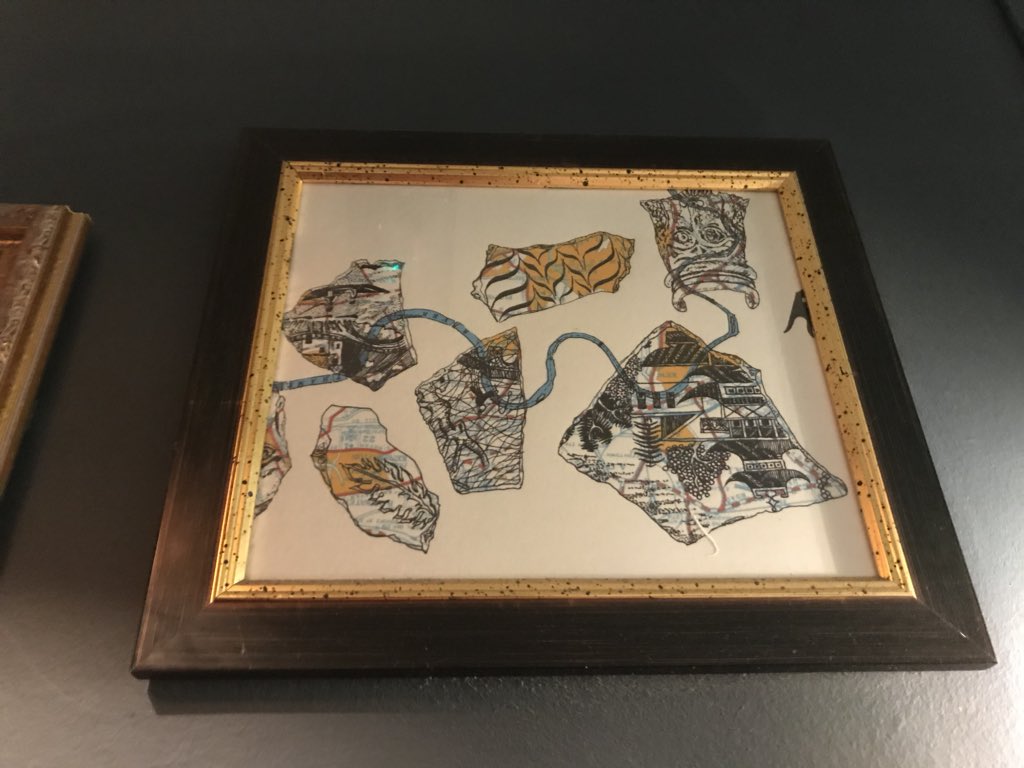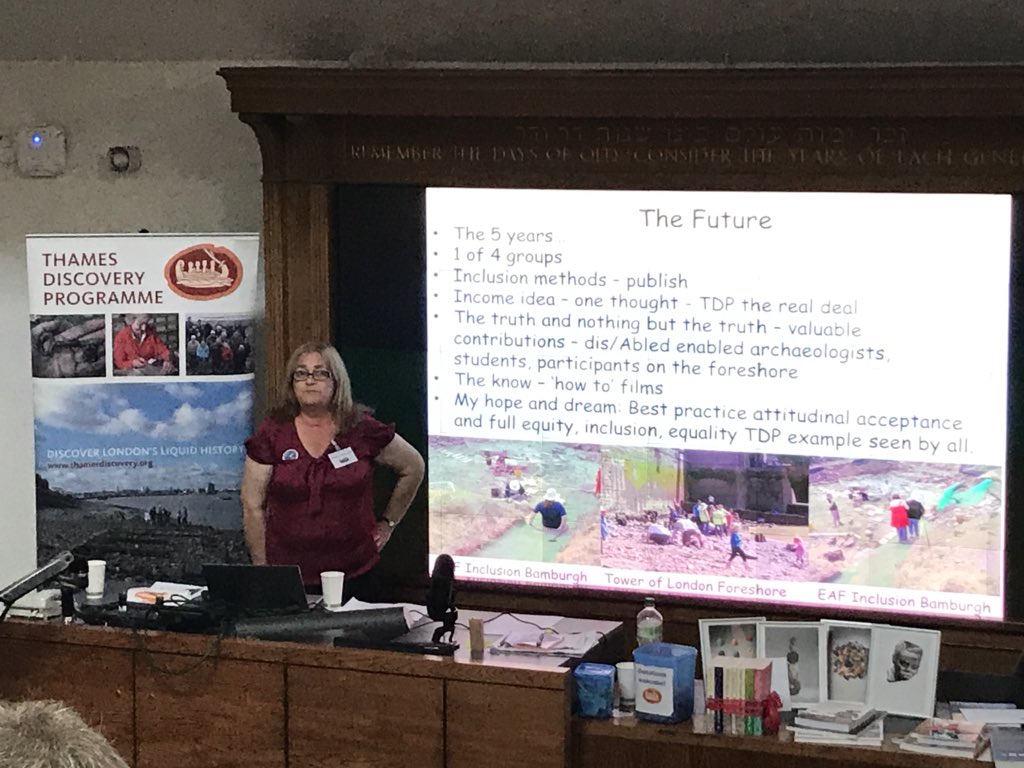Conversations about Conferences: Thames Discovery Programme's Foreshore Forum
Sarah: Anything and
everything! I wasn’t entirely clear what a foreshore even was, so there was
nowhere to go but up. The whole trip was somewhat a surprise as Della was the
invited speaker but due to a medical emergency I was asked to fill in. I did
get to meet some of the Thames Discovery Programme (TDP) folks at the EAAs the month before, their papers that gave me a good overview of TDP's mission
and activities. Their Foreshore survey volunteers are called FROGS…I always
wanted to be a FROG!
I
did think we’d hear lots from these FROGs and their experiences volunteering
along the river to monitor and record changes to shoreline archaeological
sites. And I did know in advance that I’d get a chance to do a little foreshore
survey or foreshore watch with TDP staff and CITiZAN folks (Stephanie Ostrich,
Project Officer).
Emma: What did you hope to get out of the Foreshore Forum?
Sarah: I
hoped to bring back some good ideas about how to involve volunteers even more
on the shoreline. We have some coastal sites where the public have helped us
monitor and record changes, but not many of these sites are along rivers. I
think any public archaeology program also needs the energy of new ideas to help
invigorate volunteers, otherwise interest can start to lag. I came to learn TDP
would be celebrating their 10th anniversary- and while FPAN is 13+ years old, our HMS Florida monitoring program is really just getting
started. It’s really helpful to see how these kinds of programs operate in
another country with different preservation and protection laws. The fact that
site locations are not public information is one of the main hurdles we constantly
have to work at to overcome- so how does outreach work in a vacuum where the
locations are publicly known and promotion of the program is less limited?
Emma: What did you actually learn?
Sarah: Wowza…where
to begin. Have you ever heard of a Mudlark?
Sarah: A
Mudlark! I had actually heard of the term--meaning people who collect things
along the Thames--but had not realized the long history and the specificity the
term has to the Thames.
I also learned the Thames is a truly unique cultural landscape feature that has changed much over time- prehistorically and historically. I really liked how the presentations ranged from historical documentation of activities along the river from art of various mediums, to the archaeology being done today for the Super Sewer...projects on a scale hard to believe that uncover wooden locks and landing features going back hundreds and thousands of years.
 |
| Clever painting of sherds found along the Thames with river threading through. Painting on the wall of The Mudlark. |
 |
| Definition of a Mudlark on the wall of The Mudlark. |
I also learned the Thames is a truly unique cultural landscape feature that has changed much over time- prehistorically and historically. I really liked how the presentations ranged from historical documentation of activities along the river from art of various mediums, to the archaeology being done today for the Super Sewer...projects on a scale hard to believe that uncover wooden locks and landing features going back hundreds and thousands of years.
 |
| Stella from MOLA shows denstiry and activities along foreshore in earlier days. |
Emma: What was the hardest part of attending the Foreshore Forum?
 |
| Celebrating #tenyearsofTDP by cutting the cake. Image: Chris Haworth @Luceleaf6 via Twitter. |
Sarah: I
tried to live tweet the forum, but some moments could not be captured by text
or photo. Tom Dawson (SCAPEhttp://www.scapetrust.org/) showed a history of archaeology in television programming
with the general thesis that for archaeologists to be in control of what’s
communicated about our sites, we need to get behind (and in front) of the
camera ourselves. Also- the taste of the TDP 10 Year celebration cake…the beauty
can somewhat be captured, but to truly taste it one had to be thereJ
Emma: What from the Foreshore Forum will you bring back to the
public for their benefit?
Sarah: We’re
already looking for where we have foreshore here. Some sensitive areas around
the Castillo de San Marcos or Fort Clinch might be the same kind of environment
where we could launch similar programs. We don't use the term foreshore here that I know of, but is similar to litorral (meaning land between the high and low tide marks). The Foreshore forum also demonstrated
best practices in expanding audiences- from the TaDPole youth program to the very
moving presentation by Theresa O'Mahony, founder of Enabled Archaeology Foundation. It takes an open mind to let others in,
but isn’t that what FPAN is all about?
 |
| Josh training TaDPoles. Image: MOLA @MOLArchaeology via Twitter. |
 |
| Theresa O'Mahony, Enabled Archaeology Foundation. |
Emma: What direct activities did you do?
Sarah: A few days before the forum I had the opportunity to do a foreshore walk with Eliott, Josh, and Stephanie. We walked the segment at Rothilde, meeting at the tube stop of the same name. That was pretty cool- to realize there are staircases down to the shore all along the Thames, many with historical names and located on historic maps. Once down on the shore, we started to walk upriver. The density of artifacts—ceramics, glass, nails, wooden boat parts—was pretty awesome. I didn’t understand how packed the Thames would have been with boats and ships in historic times. For instance, Josh and Eliott shared in one day it was recorded that 2,000 boats were recorded in the river. That’s A LOT of boats! And the boats would have been broken up on the beach, or lots of other activities in the past centered along the water. The deposits were compounded by continuous dredging the dumping of the river’s sediment up on the shore. And now everything is eroding so fast, because of rising tides but also the dredging/dumping cycle no longer happens, in otherwords the foreshore is no longer maintained.
 |
| Wooden feature recorded in place along the Thames. |
During the forum I tweeted from the audience so others could benefit from my being there, and then my paper was just before closing on the forum on Sunday.
Emma: Anything that surprised you?
Sarah: I didn't expect to learn American history as part of the walk, but there I was at the foot of the Mayflower pub where THE Mayflower set off (and returned!) from our shores. The Captain of the Mayflower is also buried in an unmarked grave in a nearby cemetery.
 |
| UK and USA flags mark where the Mayflower launched. |
I
really enjoyed the feedback from my presentation. The talk centered on FPAN’s
citizen science programs, from Heritage Awareness Diving Seminar (HADS), Sumberged Sites Education and Archaeological Stewardship program (SSEAS), Cemetery Resource Protection Training (CRPT), Heritage Monitoring Scouts (HMS Florida) and submerged HMS. I’m glad I threw CRPT into the mix, because I think
there’s nothing really like it over in the UK and lots of people are
interested in historic cemeteries over there. They’ve never heard of D2, the
biocide used most commonly to clean headstones in the states. And the issues
around abandonded African American cemeteries in the American South are different than many other places in the world. It helped
point out to me one of the key differences I hadn’t thought of before when it
comes to doing archaeology in America. Many of us state we do archaeology to
end racism. Not to say this isn’t why some British archaeologists are
practicing today, but our history and charge in education, to prepare students to participate in our pluristic democracy, provides a unique context for why we do our work.
 |
| Sarah presenting at TDP Foreshore Forum. Image: Stephanie Ostrich @Steph_Ostrich via Twitter. |
 |
| Sarah presenting at Foreshore Forum. Image: Nautical Archaeology Society @NautArchSoc via Twitter. |
Emma: Got future plans for another Foreshore Forum?
Sarah: I
wish! This is likely a one-off for me, but I do plan to put lessons learned from the
forum into 2019 Keeping History Above Water in St. Augustine and the 4th annual Tidally United Summit in Pensacola 2019.
 |
| Medieval sherd recorded along the Thames. |
 |
| Final thing just for fun- raffle to guess how many sherds in the jar! What would you guess? |
For more information:
Foreshore Forum Presentations now up on YouTube!
https://www.youtube.com/playlist?list=PLQwq93VVvYbkb-uLuc-4AGSWJ4VQkVhdu
ThamesDiscovery Programme project page
#foreshoreforum on Twitter to see live tweets from the event.
FROG Blog
https://www.youtube.com/playlist?list=PLQwq93VVvYbkb-uLuc-4AGSWJ4VQkVhdu
ThamesDiscovery Programme project page
#foreshoreforum on Twitter to see live tweets from the event.
 |
| Or pick up a copy of The River's Tale! |
Text
and Images: Sarah Miller, FPAN staff except where noted
